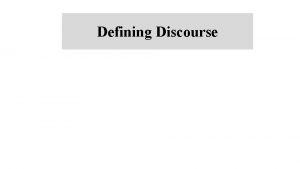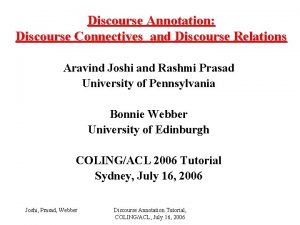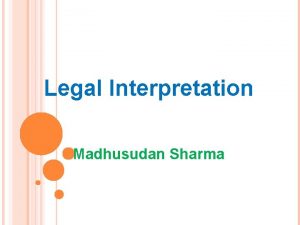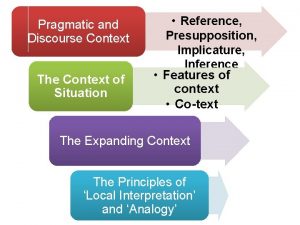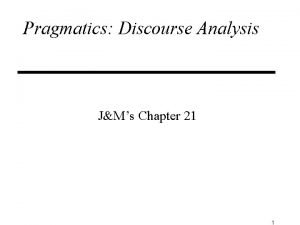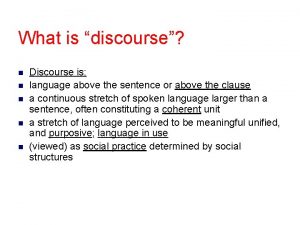The Role of Context in Interpretation Discourse context































- Slides: 31

The Role of Context in Interpretation

Discourse context l A discourse analyst takes account of context in which discourse occurs. l Most obvious elements that require contextual information for their interpretation are deictic forms. l Discourse analyst is concerned with the relationship btw the speaker and the utterance. l Reference, presupposition, implicature, inference.

Context and Shared Knowledge l Use language in the continuous and changing context of our daily life l These contexts are seen as situations in which we find ourselves, time and place, here and now of the home, school etc. l When talking people will make reference what is present in such situations- both place (here) and time (now)

Context and Shared Knowledge l l l The chalk is over there. (On the table by the window) Pass me the tape measure. (The one in your hand) There's a page missing. I like the look of that. Is that the time? (Five passed two as shown by the clock on the wall) People understand what is said by making a connection between the language and the physical context.

Context and Shared Knowledge • When such utterances are isolated from this shared situation, they have nothing to point to, so lose their point. over there could be anywhere, the time could be any time. l Being present in the same physical situation is not a guarantee that listeners will make the required connection: they may still fail to identify just what is being indicated (Over there. . . where do you mean? , I like the look of that. . . the look of what? ). l So the co text of an utterance cannot simply be the situation in which it occurs but the features of the situation that are taken as relevant. Context is not an external set of circumstances but a selection of them internally represented in the mind.

Features of context l l Context is an abstract representation of state of affairs. This may be constructed directly from immediate concrete situation. But it need not be. It can be entirely independent of such situational factors. Example : An utterance overheard between two people in a crowded train – He has put it in a safe place and it will not be found.

He has put it in a safe place and it will not be found. l l l The situation when and where the utterance was actually produced has no contextual relevance. They know what they are talking about because they have established the context of shared knowledge and assumptions that the actual language they produce keys into. In sum, the context is the common knowledge of the two people concerned, which will have been established in their previous conversations.

He has put it in a safe place and it will not be found. l l l The situation when and where the utterance was actually produced has no contextual relevance. They know what they are talking about because they have established the context of shared knowledge and assumptions that the actual language they produce keys into. In sum, the context is the common knowledge of the two people concerned, which will have been established in their previous conversations.

Text-activated Context l Context is not what is perceived in a particular situation, but what is conceived as relevant, and situational factors may have no relevance at all. This is particularly clear with written communication. l There must be an appeal of shared knowledge or otherwise no communication can take place at all. Some of this context will be created by means of the text itself.

Text-activated Context l The following is the opening paragraph of a magazine article: With 300 million native speakers scattered across 20 countries, Arabic is the world's sixth largest language. Yet British ignorance of and indifference to the Arab world remains startling: of 737 postgraduate students in Islamic or Middle Eastern studies funded by the Economic and Social Research Council last year, 12 were British nationals. ('Learn among the chickens', Rachel Aspden, New Statesman, 27 September 2004)

Text-activated Context l l l In the opening sentence, the writer provides information to establish the context of shared knowledge. Notice, however, that she assumes that this will activate knowledge that is not made explicit in the text: that the Arab world is to be identified with Islam and the Middle East, for example. Unless such knowledge is activated, the text makes no sense. To note is that text does not in itself establish context but serves to activate it the reader’s mind. And once activated; it can be extended by inference. Thus in the above text here, it may not be part of a reader's contextual knowledge that the Arab world is to be equated with Islam and the Middle East, but it becomes so by the inference of a connection across two parts of the text. To summarize the story so far. Context is a psychological construct, a conceptual representation of a state of affairs.

Context and Shared Values l Context can be thought of as knowledge of the world that a text is used to refer to, but of the world as it is known by particular groups of people. And this has not only to do with what these different groups know about as matters of fact (and others do not), but also with their distinctive way of thinking about these things. l Consider the previous text titled ‘Learn among the chickens’, the writer does not only take it for granted that the reader will know about the connection between the Arab world and Islam, which is a matter of fact, but also that the reader will share her point of view about the state of affairs that she describes and so accept the force of what she is saying.

Context and Shared Values l Context can be thought of as knowledge of the world that a text is used to refer to, but of the world as it is known by particular groups of people. And this has not only to do with what these different groups know about as matters of fact (and others do not), but also with their distinctive way of thinking about these things. l Consider the previous text titled ‘Learn among the chickens’, the writer does not only take it for granted that the reader will know about the connection between the Arab world and Islam, which is a matter of fact, but also that the reader will share her point of view about the state of affairs that she describes and so accept the force of what she is saying.

Context and Shared Values l The expression British ignorance of and indifference to the Arab world remains starting is not a statement of objective fact but the assertion of opinion, and one that the writer assumes the reader will accept. Appeal is made here not to shared knowledge but to shared values. l How kinds of contextual knowledge are conventionally structured. Explore the concept of schema.

Iraklılara Arapça eğitim veren özel lise Eskişehir’de, Irak vatandaşlarına yönelik ‘Arapça’ eğitim verecek lise açılıyor. Okul açılacağını duyan vatandaşlar önce sevindi, ardından okulun Iraklılara özel Arapça eğitim vereceğini öğrenince büyük bir hayal kırıklığı yaşadı. Eskişehir'in Odunpazarı ilçesine bağlı Şahintepesi Mahallesi'nde önümüzdeki hafta eğitime başlayacak Özel Nabaa Alhayat Karma Lisesi, sadece Irak vatandaşı çocuklarına yönelik Arapça eğitim verecek. IRAK BAYRAĞI ASILDI Milli Eğitim Bakanlığı'ndan onaylı olduğu belirtilen Özel Nabaa Alhayat Karma Lisesi'nin karma eğitim vereceği öğrenildi. Okulun girişine, Özel Nabaa Alhayat Karma Lisesi'nin tabelası asılırken tabelada ve tabelanın yanındaki afişin Arapça olması dikkat çekti. Mahalle sakinleri, mahallelerine okul açılacağını duyduklarını ve sevindiklerini ancak açılan okulun Arapça eğitim veren bir okul olması ile şaşırdıklarını ifade ettiler. Okulun arka bahçesine dikilen bayrak direklerinden bir tanesine Türk Bayrağı asılırken bir tanesine ise Irak bayrağı asıldı.

Iraklılara Arapça eğitim veren özel lise ARAPÇA TABELA TEPKİSİ Birçok belediye, işyerleri isimlerinin Türkçe olması konusunda çaba harcarken ve yabancı dilde yazılmış tabelaları sökerken Milli Eğitim Bakanlığı'na bağlı bir kurumun duvarlarına Arapça tabela ve pankart asması mahalle sakinlerinin de tepkisinin neden oldu. Özel Nabaa Alhayat Karma Lisesi'nin önümüzdeki günlerde tadilatının biteceği ve birkaç güne eğitime başlayacağı öğrenildi. 14/10/2018 - Sözcü

Reference l l Reference is the relationship between words and things: Words refer to things. It is speaker who refers (Lyons 1968). l Referring is not something an expression does, it is something that someone can use an expression to do (Strawson 1950). l Reference is treated as an action on the part of the speaker / writer.

Reference l l Reference is the relationship between words and things: Words refer to things. It is speaker who refers (Lyons 1968). l Referring is not something an expression does, it is something that someone can use an expression to do (Strawson 1950). l Reference is treated as an action on the part of the speaker / writer.

(1)A: My uncle’s coming home from Canada on Sunday B: how long has he been away for or has he just been away? A: Oh no they lived in Canada eh he was married to my mother’s sister ++ well she’s been dead for a number of years now + A uses the expressions my uncle and he to refer to one individual and my mother’s sister and she to refer to another.

Presupposition l l Speaker A presupposes that she has an uncle. Speaker B accepts this presupposition. Presupposition: is an assumption that the speaker makes about what the hearer accepts without challenge. Based on the common ground of the participants. The negation of a sentence logically presupposes it. a. My uncle is coming from Canada. b. My uncle isn’t coming from Canada. c. I have an uncle. a presupposes c because of constancy under negation.

After watching a film of a car accident, two questions (2) A: How fast was the car going when i turned right? B: Did you see a stop sign? (35 % say yes) l Presupposition : The car turned right. (3) A: How fast was the car going when i ran the stop sign? B: Did you see a stop sign? (53 % say yes) l Presupposition : The car ran the stop sign.

Implicatures l The speaker’s implication. Distinct from what the speaker literally says. l Speakers obey Grice’s maxims during conversation. l Conversational maxims: – Quantity – Quality – Relation – Manner l

l (4) A: I’m out of petrol. B: There’s a garage round corner. B is adhering to the cooperative principle. Implicatures l are derived from conventional meanings l are produced in a specific context shared by the speaker & hearer. l depend on the recognition of conversational maxims.

Inference Conclusion from an utterance. (5) If it’s sunny, it is warm. It is sunny → it’s warm. (6) John was on his way to shool. Entailments: Someone on his way to school. John was on his way to somewhere. Someone was on his way to somewhere l One of the inferences: John is a schoolboy. l If the original sentence is followed by (7) Last week he was unable to control the class. l Inference: John is a teacher.

The context of situation l Two scenerios with one utterance: l Speaker: young mother / Hearer: her mother-in-law / watching 2 -year-old son / the child’s father was backward at this age. (8)I do think Adam’s quick. l Speaker : a student / Hearer: Students / Speaker tells a joke / Everyone excepts Adam laughs. Then Adam laughs I do think Adam’s quick. l Different contexts cause different interpretations.

Features of contexts l l l l l Addressor → Adressee → Topic → Setting → Channel → Code → Message-form→ Event → Key → the speaker the hearer discussed subject time and place speech / writing / signing style of language chat / debate / love letter embedding of a larger event purpose

(9) I must admit I‘m very nervous l l l l Addressor: a young scientist Addressee: a researcher Channel: speech Message-form: conversation Event : embedded in an interview Topic: his nervousness Setting: Edinburg University, 1970 s It’s unlikely that the following utterances occur: - Please pass the marmalade. - My cat has just been sick again. - Get into the box.

The co-ordinate of the index (Lewis 1972) l l l l Possible-word co-ordinate: state of affairs; might be, could be… Time co-ordinate: tensed sentences, adverbials (e. g. today) Place co-ordinate: sentences like here it is Speaker co-ordinate: first person references (I, me, we, our) Audience co-ordinate: you, yourself etc. Indicated object co-ordinate: demonstrative phrases: this, those Previous discourse co-ordinate: the latter, the aforementioned Assignment co-ordinate: a finite series of things (set of things, sequence of things)

l Deictic terms can only be interpreted by the context. (10)Place two fingers in the two holes directly to the left of the finger stop. l Do we have difficulty in interpreting this utterance? l If we know the previous discourse: l It is worth remembering how to dial 999 in darkness or smoke. (11) SQUASHED INSECTS DONT BITE MAD MENTAL RULE l Does the language sound meaningful or obscure?

13: addressed to a specific reader. If we know the context that it is written by the street gagsters called Mad Mental and if we divide this unpunctated interaction into two parts: (12) SQUASHED INSECTS DONT BITE MAD MENTAL RULE If we change the context, the effect changes. 2 speakers: (13) I’m skipping l l l Speaker : 3 -year-old girl. ( We think it’s a great success) Speaker: 8 -year-old girl who is know to be a good skipper. ( It is a predictable result)

(14) A: Are you often here? B: Quite often + about once a month + actually + I come up to see my children. l l What do we infer if the speaker would be a man of 70 s? What do we infer if the speaker would be a man of 30 s? What do we infer if the speaker would be a woman of 30 s? All the inferences we draw arise because of the alteration of the context.
 Context of interpretation
Context of interpretation What is discourse
What is discourse How does interpretation b differ from interpretation a
How does interpretation b differ from interpretation a Worker role azure
Worker role azure Krappmann modell
Krappmann modell Role conflict occurs when fulfilling the role expectations
Role conflict occurs when fulfilling the role expectations High context vs low context culture ppt
High context vs low context culture ppt Communicating across generational differences
Communicating across generational differences Example of presupposition
Example of presupposition Verbal adalah
Verbal adalah So nguyen to
So nguyen to Thiếu nhi thế giới liên hoan
Thiếu nhi thế giới liên hoan Tỉ lệ cơ thể trẻ em
Tỉ lệ cơ thể trẻ em Tia chieu sa te
Tia chieu sa te Các châu lục và đại dương trên thế giới
Các châu lục và đại dương trên thế giới Thế nào là hệ số cao nhất
Thế nào là hệ số cao nhất Hệ hô hấp
Hệ hô hấp Tư thế ngồi viết
Tư thế ngồi viết Bàn tay mà dây bẩn
Bàn tay mà dây bẩn Hình ảnh bộ gõ cơ thể búng tay
Hình ảnh bộ gõ cơ thể búng tay đặc điểm cơ thể của người tối cổ
đặc điểm cơ thể của người tối cổ Cách giải mật thư tọa độ
Cách giải mật thư tọa độ Tư thế worm breton
Tư thế worm breton Tư thế ngồi viết
Tư thế ngồi viết ưu thế lai là gì
ưu thế lai là gì Chó sói
Chó sói Thẻ vin
Thẻ vin Thể thơ truyền thống
Thể thơ truyền thống Các châu lục và đại dương trên thế giới
Các châu lục và đại dương trên thế giới Từ ngữ thể hiện lòng nhân hậu
Từ ngữ thể hiện lòng nhân hậu Diễn thế sinh thái là
Diễn thế sinh thái là Ng-html
Ng-html




































